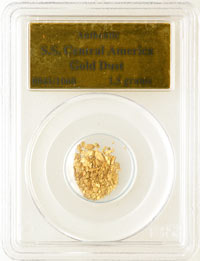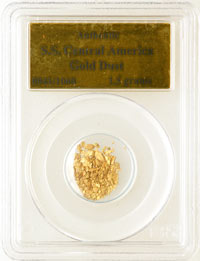
|
Sale 60
Pre-Long Beach Coin Auction
| Lot |
Photo |
Description |
Realized |
Lot 3477 |
|
S.S. Central America Gold Dust. Each holder contains 1.5 grams. Each in an authentic PCGS gold label holder. Lot of 5 holders.
Estimated Value $500 - 600.
From the shipwreck site.
View details
| Realized
$661 |
Lot 3478 |
|
S.S. Central America Gold Dust. Each holder contains 1.5 grams.Each in an authentic PCGS gold label holder. Lot of 4 holders.
Estimated Value $400 - 500.
From the shipwreck site.
View details
| Realized
$529 |
Lot 3479 |
|
S.S. Central America Gold Dust. Each holder has 1.5 grams.Each in an authentic PCGS gold label holder. Lot of 4 holders.
Estimated Value $400 - 500.
From the shipwreck site.
View details
| Realized
$529 |
Lot 3480 |
|
S.S. Central America Gold Dust. Each holder contains 1.5 grams. Each in an authentic PCGS gold label holder. Lot of 3 holders.
Estimated Value $300 - 375.
From the shipwreck site.
View details
| Realized
$449 |
Lot 3481 |
|
S.S. Central America Gold Dust. Each holder contains 1.5 grams. Each in an authentic PCGS gold label holder. Lot of 2 holders.
Estimated Value $200 - 250.
From the shipwreck site.
View details
| Realized
$293 |
Lot 3482 |
 |
S.S. Central America Gold Dust. 1.5 grams. In an authentic PCGS gold label holder.
Estimated Value $100 - 125.
From the shipwreck site.
View details and enlarged photo
| Realized
$150 |
Lot 3483 |
 |
S.S. Central America Gold Dust. 1.5 grams. In an authentic PCGS gold label holder.
Estimated Value $100 - 125.
From the shipwreck site.
View details and enlarged photo
| Realized
$150 |
Lot 3484 |
 |
S.S. Central America Gold Dust. 1.5 grams. In an authentic PCGS gold label holder.
Estimated Value $100 - 125.
From the shipwreck site.
View details and enlarged photo
| Realized
$150 |
Lot 3485 |
 |
1849 Oregon Exchange Co. (Oregon) $5 Gold "Beaver". NGC graded AU-55. Lovely rich golden toning. Well struck for this issue. A dramatic and historic offering of this very rare $5 gold issue. Oregon pioneers were some of the earliest pioneers to hear about the gold discovery in California. Since they were close at hand, they were among the earliest prospectors to reach the gold fields. It has been said that upwards of two-thirds of Oregon's male population relocated to California in the ensuing years! Seizing the opportunity to make a profit, in 1849, the Oregon Exchange Company was formed, comprising a group of politicians and merchants. Principals included William K. Kilborn, Theophilus Magruder, James Taylor, George Abernathy, William H. Wilson, William H. Rector, John Gill Campbell, and Noyes Smith. This group of individuals formed the Oregon Exchange Company shortly after the arrival of General Lane.
The Oregon Exchange Mint struck $5 and $10 gold coins in a converted two-story building in Oregon City. On the obverse of the coin is a beaver, said to be emblematic of the productive Oregonian. The initials of each partner were placed on the obverse die and appear on the coins. The design is credited to John Gill Campbell. The dies were made by Hamilton Campbell and William H. Rector. 6,000 pieces were first struck of the $5 gold coins, with an error in one of the initials (TO instead of OT for Oregon Territory). This error was put right on the subsequent $10 dies. Only 2,850 examples of that denomination were struck over the six-month period of operation. The mint ceased operations on September 1, 1849.
The "beavers" were popular with merchants since they filled an urgent need for high-value circulating gold coins; these, and other Territorial issues circulated widely until the San Francisco Mint could be built and begin operations (1854). The Oregon coins were made of local unalloyed metal, many of which were worth more that they purported to be and were eventually melted thus accounting for their scarcity today. The present example displays balanced wear and a pleasing, natural reddish-gold color with tinges of luster patina about the devices. As a rule these were crudely struck, but the present on the present coin, the beaver's facial features are visible, as is a great deal of its fur (in the form of parallel lines along the body). A few small abrasions are notes, with a short mark at the obverse rim at approximately the 9 o'clock position, a short scuff above the "W."; also, faint traces of a rim bump opposite the head of the beaver, but none are of particular distraction. The reverse carries a simple legend. Around: OREGON EXCHANGE COMPANY. Within: 130G. / NATIVE / GOLD. / 5D. An outstanding find for the serious collector of Territorial Gold. Pop 2; 3 finer (PCGS # 10288) .
An excellent reference on the Oregon gold pieces is Dr. Donald Kagin's Private Gold Coins and Patterns of the United States, a must-have in any scholarly library. Kagin explains the urgent need for these gold coins at the time of the Gold Rush:
"Like the Mormons, the Oregon settlers made use of the California gold dust to issue coins prior to the first private mint of San Francisco. This was probably in part because many more settlers were in Oregon at the time than in Northern California. Trapping and trading were well established enterprises in Oregon when gold was discovered in California, and the Oregon settlers were quick to take advantage of the new-found commodity.
"Fur, or the search for fur, is the main feature of the history of early Oregon. Not only did beaver, otter, mink, and marten pelts bring about the commercial development of the Pacific Northwest, long before the discovery of gold in California, but they were extensively used as a Western medium of exchange decades before the use of gold coins.
"The demand for furs led to a three-sided contest in the late eighteenth and early nineteenth centuries for possession of the Pacific Northwest. The Russians moved into Alaska in 1780 while the British and Spanish left Nootka Sound in 1790. In 1821, the United States took over the Spanish claims in Oregon, its political position having been greatly strengthened by the preliminary spadework done by the Boston merchants and the American Fur Company formed by John Jacob Astor in 1811."
Estimated Value $60,000 - 70,000.
View details and enlarged photos
Check results on similar lots
| Unsold |
|
|